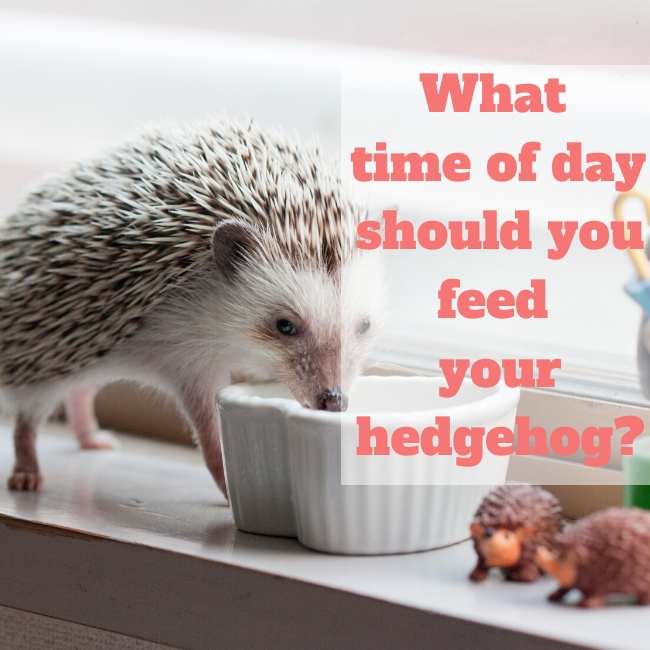One of the first questions a new owner will have is, “How much should my hedgehog eat and drink in a day? Nutrition is a vital health consideration for any species of pet, but hedgehog nutrition can be particularly challenging. The nutritional research and literature for exotic species are not nearly as thorough as what is available for common pets like cats or dogs.
A full-grown hedgehog should be drinking 25-40 milliliters (1.5 -2.5 tablespoons) of water each day. Young hedgehogs drink far water more daily, owners have measured as much as 60 milliliters (4 tablespoons) in a single night. Extremely active hogs may drink even more than this.
How much water should hedgehogs drink?
The internet abounds with inaccurate information on how to care for hedgehogs so I actually reached out for an expert’s opinion! Dr. Mark Burgess of OSU Veterinary School has 20+ years of experience treating African Pygmy hedgehogs and shared the following with us:
“Clean water should be provided at all times; the animal will drink what is needed. Pets drink more when fed mostly dry food, or during hot weather. Live insects and canned food contain more moisture, and if fed liberally, may provide enough water to reduce drinking. In general, most animals need approx. 1 ounce (30 ml) of water per pound of body weight daily. The main rule is that water is always available, and the animal drinks somewhat consistently. A big increase in water consumption (over normal volumes for that pet) may be concerning, as it can sometimes indicate a disease condition such as kidney failure or diabetes.”
It is very difficult to judge how much your hedgehog is drinking when using a water dish. Traditional water dishes can also easily get bedding or food mixed in which means you’ll be constantly rinsing and changing your pet’s water. I recommend using a water bottle; these can easily be attached to the side of your pet’s cage. This will cut down on messes and make it simple to keep an eye on how much your hedgehog is drinking each day.
If your hedgehog’s water bottle has millimeter markings you can just make a quick note of the water level before going to bed and record how much water they drank after checking it again in the morning. You can also mark measurements onto the bottle with a pen if your bottle was not printed with them.
This post contains affiliate links; if you snag a deal through my link it will send some spare change my way to keep this slice of the internet up and running.

How much food should hedgehogs eat daily?
A hedgehog will typically eat between 1 tablespoon to ¼ cup of kibble depending on your hedgehog’s metabolism, stage of growth and activity level. With most active adults that are not reproducing, 2 teaspoons of kibble daily is often adequate. Baby hoglets, nursing or pregnant mothers should be allowed to free-feed as much as they want.
If your hedgehog is having weight issues (whether it is over or underweight) you will need to work with your veterinarian to find the perfect amount of kibble. Each hedgehog has its own unique needs and the amount of food can highly vary depending on their age, weight, and activity level.
Burgess advises “The question of how much to feed isn’t so simple. Just as in a human, no one can make a general statement of how many calories everyone should consume daily. The caloric requirement of an individual is determined by various factors, including age, maturity, pregnancy and nursing, exercise and activity level, health status, body size, and individual variances in metabolism.
You can’t tell a doctor that you’re 5 feet 7 inches tall and then ask, “how many calories do I need daily?” Well, it depends…are you a 25-year-old distance runner or are you a 55-year-old who works behind a desk all day? There is no one general recommendation that fits everyone. The same is true for hedgehogs. Different foods can vary greatly in caloric content, which changes the amount of food needed for each brand.
With that said, we can still offer some guidelines. Assuming the food is appropriately formulated (30-35% protein and 5-9% fat for dry kibbles), babies and pregnant/nursing females can usually be fed ad libitum (free-choice). With most active adults that are not reproducing, 2 teaspoons of kibble daily is often adequate; more may be needed for very active animals eating very lean kibbles. Running on an exercise wheel daily burns a lot of calories, helping prevent obesity, and allowing a bit more food consumption. Metabolism and activity levels may slow with age, necessitating a decrease in food volume.”
Overweight Hedgehog Diet Tips
If your hedgehog is overweight your vet may have you slowly dial back the amount of food until a healthy weight is reached. Burgess states “The best general recommendation that applies to all animals is to feed as needed to achieve proper body conformation. If the animal is too thin, then increase feedings; if too fat, then slowly decrease feedings (rapid weight loss should be avoided). A hedgehog at an ideal weight is nearly twice as long as wide when unrolled. In food terms, they are shaped like a Hostess Twinkie, not a marshmallow. If a hedgehog is ‘round’ when not rolled up, then it is likely obese.”
You should periodically weigh your hedgie to ensure they stay at a healthy weight. I use this digital kitchen scale to keep track of my hedgehog’s weight. I have a journal that I track her weight in; we do a weigh-in every 3-4 weeks. Heavenly Hedgehogs has a great hedgehog weight guide if you want more information on treating/preventing obesity in your pet.
If you are just starting out in your hedgehog ownership journey I highly recommend that you read West Coast Hedgehog’s Care Guide. It’s a free download written by Kimberly Halzen (an Oregon based breeder with bachelors degrees in animal sciences + sustainability). There is a very meaty section on nutrition and how to deal with overweight/underweight hogs.
How many insects do hedgehogs need every day?
You will also need to feed your hedgehog a mix of insects (live or dried) with their daily kibble. We feed our hedgehog 3-4 whole grasshoppers or 4-5 mealworms per week. Her activity level borders on sedentary, a more active hedgehog would benefit from more insect treats.
Burgess advises “If insect prey are used, they should be limited in amount, used strictly as ‘treats’ to help prevent obesity, which is a common problem in pet hedgehogs. Excessively fatty prey such as mealworms, superworms and waxworms should be minimized. Crickets and Dubia roaches are a little less fatty and more protein-rich. All these insects are severely calcium-imbalanced (deficient), but if fed as a minor part of the diet, this isn’t as concerning. Earthworms are protein-rich, low in fat, and calcium balanced, making them good food items. They still contain calories, so they should be fed sparingly on top of a pellet-based diet.
Superworms are the larger cousin of mealworms and can be fed 1-2 times a week. Dubia roaches are also a good feeder insect for hedgies. Please note that these feeding recommendations cannot be combined. 1-2 grasshoppers, dubia roaches, and superworms etc would be far too fatty for a single hedgehog to consume frequently.
You can purchase superworms, roaches, grasshoppers and other insects at your local reptile supply, pet store, or online.
Some owners opt to occasionally feed pinkies (baby pink finger-sized mice) as a treat to their hedgehog. Pinkies are a great source of calcium but are also low in fat. Pinkies can be fed once or twice a month as a special treat.
How often can you feed a hedgehog treats?
Hedgehogs love the occasional treat! You can feed them a special treat once or twice a week. Be sure to soak greasy meat like hamburger in water before feeding and never use oil or butter while cooking for your pet. Here are some healthy and hedgie approved treat ideas:
- Cooked chicken/turkey
- Hard-boiled or scrambled egg
- Meat flavored baby food
- 93% lean cooked hamburger

What time of day should you feed your hedgehog?
Hedgehogs are nocturnal which means once in the early evening and once in the morning feeding times are optimal. Hedgehogs are very flexible about feeding times and will easily adjust to a new schedule, but be sure to try to feed around the same time each day.
Some people feed twice a day, morning and night, others feed once a day. Burgess advises that “Food is usually fed in ½ portions twice daily, so the pet gets a couple of meals a day, rather than consuming all their food in a few hours and fasting for the next 20 hours.”
